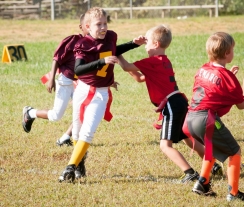Common Hip Injuries in Kids
By Kevin Shea, MD
Pediatric athletes are subject to several different acute hip injuries. These injuries include problems around the growth plate and around the femur and pelvis. In some cases, acute symptoms can develop in association with previous hip conditions. Two common hip injuries are discussed below.
Slipped Capitol Femoral Epiphysis (SCFE)
Young athletes may develop significant pain during sports participation. Other athletes may present to a doctor’s office with the chief complaint of pain in the hip, thigh, and/or knee. In patients with open growth plates, fractures may develop. These fractures may be a displaced fracture, where the bone snaps into two or more parts and moves so that the two ends are not lined up straight. In other cases, a fracture may occur on a pre-existing stress fracture of the growth plate. In each of these instances, an evaluation of the hip joint is necessary to ensure there is no evidence of a femur (large leg bone) fracture or SCFE. These athletes may present with sudden onset of pain, limp, or inability to bear weight. In some cases, they may also have a history of previous hip pain/discomfort, and loss of motion in some cases. These injuries require urgent evaluation, and prompt referral to an orthopaedic specialist. Delayed treatment can lead to disruption of the blood supply to the hip, and may predispose the athlete to arthritis in the future.
Hip Avulsion
A hip avulsion is an injury that occurs when a small chunk of bone that is attached to a tendon or ligament gets pulled away from the main part of the bone. This injury may occur in several areas around the hip joint. In many cases, they are associated with sprinting activities, including track/field, soccer, basketball, football, etc., and are due to very high impact forces on the tendon/muscles that attach to the bone. Hip avulsions can be identified by physical examination in some cases, although specific location of the injury is not always possible with examination alone. X-rays may be beneficial to identify the specific tendon and bone avulsion regions. While most of these injuries do not require emergent treatment, the recovery can take several months. Early evaluation, activity restriction, and appropriate therapy and return to sports will improve the outcome. It is important for parents and coaches to be aware of hip pain in young athletes and make all necessary efforts to recognize quickly and treat to prevent future complications.
Source: In Motion – A publication of the American Orthopedic Society for Sports Medicine (AOSSM) in conjunction with Orthopedic + Fracture Specialists, Summer 2015

